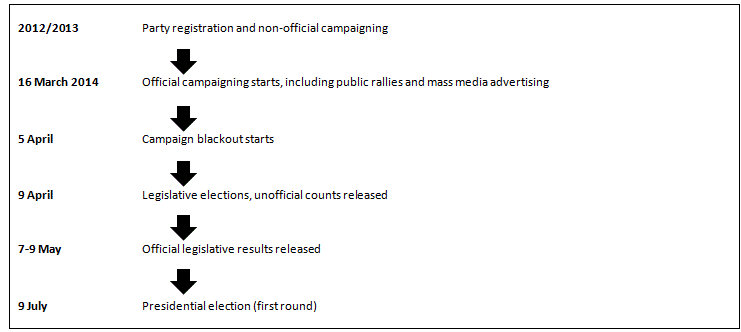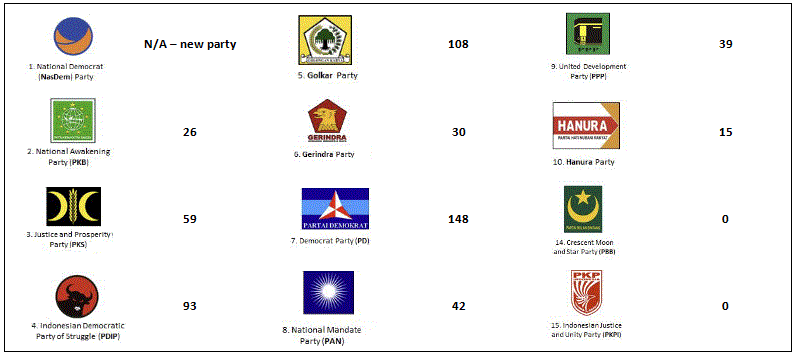28 March 2014
PDF version [494KB]
Dr Cameron Hill
Foreign Affairs, Defence and Security
On 9 April, Indonesians will vote in legislative elections at the national, provincial, and district levels. There are 12 parties contesting the national parliamentary elections. On 9 July, Indonesians will again go to the polls to choose their next president. This quick guide provides a brief overview of the national legislative and presidential elections, including the key parties and candidates, as well as links to supplementary resources.
Facts and figures
The Constitution:
- The Republic of Indonesia is a representative republic in which the President is both the head of state and the government.
- The amended 1945 Constitution of Indonesia is the foundation for the country’s system of government and provides for a separation of legislative, executive and judicial powers.
The Legislature:
- At the national level there are two elected legislative assemblies in Indonesia: the House of Representatives (Dewan Perwakilan Rakyat/DPR) and the Regional Representative Council (Dewan Perwakilan Daerah/DPD).
- the national DPR has a total of 560 representatives from 77 multi-member electoral districts, with three to ten seats in each electoral district (depending on district population), elected from political party lists through an open-list proportional representation (PR) system.
- the DPD has 132 representatives, four from each of 33 provinces. Nonpartisan candidates from the respective provinces are elected through a single-non-transferable-vote system. However, only the DPR fully legislates while the DPD has a more limited mandate.
The Executive:
- The President is the head of the executive branch and can be elected for a maximum of two five-year terms.
- A political party or coalition of political parties that wins 25 per cent of the vote or wins at least 20 per cent of the seats in the DPR can nominate candidates for President and Vice President (running as a pair).
The voters:
- Total population: 237.56 million (2010)
- Estimated number of eligible voters: 187,977,268 (2013)
- Estimated number of polling stations: 550,000
- Voter turnout in previous legislative elections: 93% (1999); 84% (2004); 71% (2009)
Source: International Foundation for Electoral Systems (IFES), Brief overview of the 2014 elections in Indonesia, unpublished paper, 2 October 2013.
Election timeline

Sources: Office of National Assessments, Snapshot: Indonesia’s legislative elections, open source centre, 4 March 2014 (subscriber only service); B Kraft, Indonesia’s 2014 elections: timetable, Center for Strategic and International Studies, 28 January 2014.
Background on Indonesia’s political and electoral system
Democratisation: achievements and challenges
- E Aspinall, ‘The irony of success’, Journal of Democracy, 21(2), April 2010, pp. 20–34.
- D McRae, ‘Indonesian politics in 2013: the emergence of new leadership?’, Bulletin of Indonesian Economic Studies, 49(3), 2013, pp. 289–304.
- M Mietzner, ‘Praetorian rule and re-democratisation in South-East Asia and the Pacific Islands: the case of Indonesia’, Australian Journal of International Affairs, 67(3), May 2013, pp. 297–311.
Parliament
Political parties
- U Fionna and A Arifianto, ‘Getting to know the contestants of the 2014 Indonesian parliamentary elections’, Perspectives, no.14, Institute of Southeast Asian Studies, 10 March 2014.
- S Hamid, ‘Indonesian politics in 2012: coalitions, accountability and the future of democracy’, Bulletin of Indonesian Economic Studies, 48(3), 2012, pp. 325–345.
- S Sherlock, Indonesia’s third democratic transition: are the parties ready for the 2014 presidential election?, Centre for Democratic Institutions, April 2013.
-
Electoral system and election management
- Lembaga Survei Indonesia/International Foundation for Electoral Systems, Pre-election national survey—key findings, US Agency for International Development, March 2014.
- V Nehru and N Bulkin, How Indonesia’s 2014 elections will work, Carnegie Endowment for International Peace, 24 October 2013.
Islam and politics
‘Money politics’
- P Blunt, M Turner and H Lindroth, ‘Patronage’s progress in post-Soeharto Indonesia’, Public Administration and Development, 32(1), February 2012, pp. 64–81.
- FB Timur and A Priamarizki, The economics of Indonesia’s election campaigns, S. Rajaratnam School of International Studies, no. 40, 26 February 2014.
-
Media, including social media
- The road to 2014: corruption, the media and parties’ electability, S. Rajaratnam School of International Studies, policy report, February 2014.
- J Chen and A Priamarizki, Popular mandate and the coming-of-age of social media’s presence in Indonesia politics post-reformasi, S. Rajaratnam School of International Studies, no. 268, 18 February 2014.
Women and politics
Election issues
Australia’s electoral assistance to Indonesia
National political parties and current seats in DPR*

* Listed in order of 2014 legislative ballot. As well as twelve nationally registered parties, three local Aceh parties will run for seats in the provincial and district parliaments. Aceh is the only province where local parties can contest elections. Source: Office of National Assessments, Snapshot: Indonesia’s legislative elections, Open Source Centre, 4 March 2014. See also: U Fionna and A Arifianto, ‘Getting to know the contestants of the 2014 Indonesian parliamentary elections’, Perspectives, no.14, Institute of Southeast Asian Studies, 10 March 2014.
Profiles and biographies of key presidential candidates
‘The frontrunner’—Joko Widodo:
Joko Widodo (nicknamed “Jokowi”), the youngest of the presidential candidates, entered politics only nine years ago as mayor of the central Java city of Solo. In 2012, Widodo became the governor of Jakarta and his unorthodox and practical approach has proved to be popular. In March 2014, he was announced as the presidential candidate for the Indonesian Democratic Party of Struggle (PDI-P), the party headed by former President Megawati Sukarnoputri. Even before the confirmation that he would run as a candidate, Jokowi has consistently topped most credible polls. To date, he has not given any in-depth interviews on his approach to issues of national importance, including foreign affairs, making it somewhat difficult to gauge what the policy implications of a Widodo presidency might be.
‘The strongman’—Prabowo Subianto:
Lt. General (ret.) Prabowo Subianto, a former head of Indonesia’s Special Forces (Kopassus), is the candidate for the Greater Indonesia Movement Party (Gerindra). Prabowo presents himself as a decisive figure who advocates a nationalist agenda.
‘The businessman’—Aburizal Bakrie:
A prominent businessman and a cabinet minister in the first Yudhoyono administration, Aburizal Bakrie is running as the candidate for Golkar, the party of former President Suharto. Bakrie has struggled in the polls to date.
PD’s choice?
The Democrat Party (PD) of the current President, Susilo Bambang Yudhoyono, has been plagued by a series of corruption scandals and is lagging in most polls. PD will choose its presidential candidate through a ‘political convention’ process.
News, polls and analysis
Seminars and events
© Commonwealth of Australia

Creative Commons
With the exception of the Commonwealth Coat of Arms, and to the extent that copyright subsists in a third party, this publication, its logo and front page design are licensed under a Creative Commons Attribution-NonCommercial-NoDerivs 3.0 Australia licence.